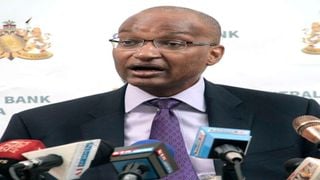
Central Bank of Kenya Governor Patrick Njoroge during a past press briefing. CBK data shows Kenya borrowed Sh432 billion in just seven months of this year to address its cash crunch problem.
| File | Nation Media GroupBusiness
Premium
Kenya borrowed Sh60bn every month this year, CBK report shows
What you need to know:
- The rise in the debt follows a 38-month loan agreement that Kenya signed in April with IMF worth Sh257 billion.
- Data released by CBK also shows that public debt rose from Sh7.28 trillion in December to a record Sh7.71 trillion last month.
Kenya has dug itself deeper into the debt pit by borrowing an additional Sh432 billion in just seven months of this year to address its cash crunch problem.
Data released by the Central Bank of Kenya (CBK) shows that public debt rose from Sh7.28 trillion in December to a record Sh7.71 trillion last month, exposing taxpayers to a higher tax burden.
The rise in the debt follows a 38-month loan agreement that Kenya signed in April with the International Monetary Fund (IMF) worth Sh257 billion ($2.4 billion) through the Extended Credit Facility (ECF) and Extended Fund Facility (EFF) for budgetary support.
Kenya has already received over Sh78 billion from IMF in two tranches — Sh34.45 billion ($314 million) in April and Sh44 billion ($410 million) in May.
Last month, the government also raised Sh107.9 billion ($1 billion) from a Eurobond offer and an additional Sh80.9 billion ($750 million) from the World Bank, in a successive borrowing spree that has further lowered Kenya’s debt-carrying capacity.
The country's single year debt borrowing is set to hit the trillion-shilling mark for the first time this year, Sh1.169 trillion, which is a third of the Sh3.65 trillion budget for the current financial year.
The borrowed monies are set to be used to service public debt, against a projected revenue collection of Sh2.039 trillion.
Government’s borrowing appetite
This means that for every Sh10 that taxpayers will pay, Sh5.7 will be used to service the piling debt.
“Kenya’s public and publicly guaranteed debt stood at Sh7.7 trillion by the end of June 2021. This comprised Sh3.69 trillion domestic debt (47.9 per cent) and Sh4.01 trillion external debt,” CBK said in its statistical bulletin.
This includes Sh171-billion debt owed by State Owned Enterprises (SOEs) that taxpayers risk shouldering should the entities default on repayment, ministerial overdrafts of Sh47 billion, suppliers credit of Sh18 billion and bank advances amounting to Sh3 billion.
The Parliamentary Budget Office (PBO) has warned that the government’s borrowing appetite risks becoming unsustainable, coming as costs of serving debt has far outstripped allocations on development expenditure.
For instance, Ministries, Departments and Agencies (MDAs) were allocated Sh659.96 billion spend on development projects, which is only 56 per cent of the funds that will be used to service debt.
“Debt servicing is expected to be a major constraint to budget financing. Accounting for over 66 per cent of domestic revenues (from 44 per cent in FY 2019/20), it will put pressure on the fiscal deficit,” PBO said.
It added: “It is also observed that the increase in debt servicing expenses has outpaced the allocations for development expenditure (for which debt is meant to finance) by over 200 per cent, implying that borrowing for development expenditure financing might no longer be a viable fiscal principle.”
But rising public spending needs in the new budget will see the government borrow an additional Sh930 billion over the next 12 months, which is set to push public debt to a historic Sh8.59 trillion by June next year.
This is set to push government closer to breaching the Sh9 trillion statutory debt ceiling, with Treasury announcing plans to petition Parliament to raise the ceiling to accommodate new borrowing.
Revision of debt ceiling
Lawmakers raised the ceiling from Sh6 trillion in October 2019.
“The formulation of this strategy has been on a background of public debt stock fast approaching the statutory ceiling of Sh9 trillion as set out in the Public Finance Management Act, 2012,” the Treasury said in its Medium Term Debt Strategy paper to Parliament in February.
“As a result, the implementation of this strategy may require the revision of the debt ceiling through the amendment of the PFM Act based on future borrowing requirements. To accommodate the fiscal deficits in FY2021/22 and into the medium term, the statutory debt limit has to be expanded.”
This comes at a time Kenyans are reeling from increased cost of living after the government imposed a retinue of new taxes in a bid to raise revenue collection.
This has raised the cost of buying crucial commodities and services such as cooking gas, airtime and internet.
Treasury has been facing a shortfall in tax revenue collected as a share of the Gross Domestic Product (GDP), driven by dwindling income tax and Value Added Tax (VAT) collection as a share of the GDP.
Ordinary revenue as a share of GDP declined from 18 per cent in the FY 2013/14 to about 15.5 per cent in 2019/20— exposing taxpayers to further debt servicing obligations as the government races to match the pace of public spending needs with resources it can avail.





